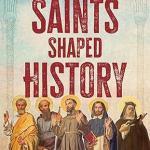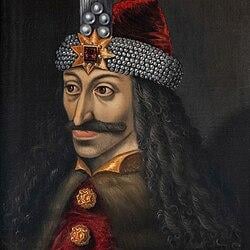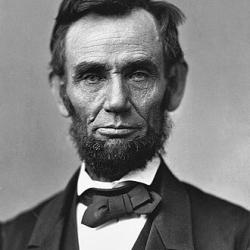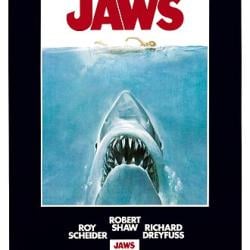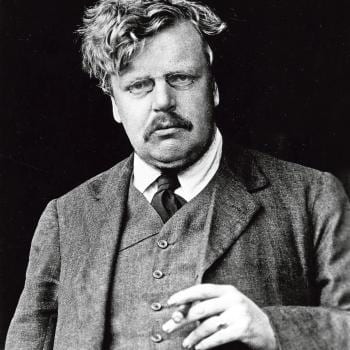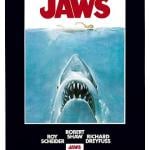LAST TIME ON HOARATS
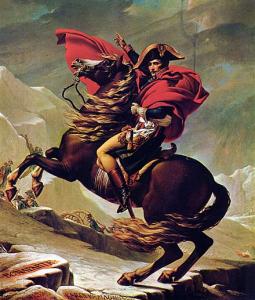
Napoleon Crossing the Alps, romantic version by Jacques-Louis David in 1805
1800: A Time To Start the 19th Century
The new century started off with a time problem. As of March 1(O.S. February 18), when the Julian calendar acknowledged a leap day and the Gregorian calendar did not, the Julian calendar fell one day further behind, bringing the difference to 12 days until February 28 (O.S. February 16), 1900.
As of the start of 1805, the Gregorian calendar was 12 days ahead of the Julian calendar, which remained in localized use until 1923.
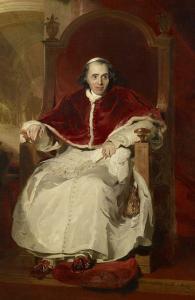
The 19th century also started off with a new pope. On March 14, 1800 the Papal conclave, 1799–1800 took place in which the Catholic church elected its 251st vicar of Christ, cardinal Barnaba Chiaramonti aka. Pius VII, Pius VI died the previous year in captivity at Valence France, on August 29, 1799. All popes have to deal with problems of some kind. Pius VII had to deal with the conquering frenchman Napoleon Bonaparte who was starting battles wherever he could lead his army.
Napoleon and the Pope
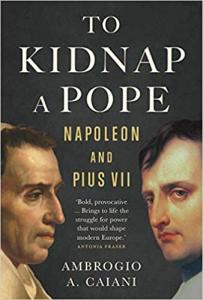
On July 18, 1801 Napoleon signed a Concordat with the pope making the Catholic church great again in France and making everything okay dokey with the Vatican. The concordat actually remained in effect until 1905, except in Alsace-Lorraine, where it remains in force to this very day.
Relations between the pope and Napoleon were cool for several years until 1809 when on May 17 Napoleon I of France ordered the annexation of the Papal States to the French Empire. When he announced to the Pius that his secular power was over he did what any good pope would do in the situation. He excommunicated him. Which led to French troops arresting Pope Pius VII on July 6 and taking him to Liguria.
Napoleon Bonaparte and Barnaba Chiaramonti, the future Pope Pius VII, were born into a world where the belfries of churches dominated the landscape. Before 1789, religious participation and worship were not mere notions, but were at the very marrow of European identity. The future emperor and pope were both born Italian Catholics. Both, too, had aristocratic roots. Physically they resembled each other. Their dark hair, eyes and tanned skin were decidedly Italian. Both were of average height, and of slim build. The biggest contrast was their gaze: where Napoleon’s was fiery and intense, Pius’s was beneficent, kindly. They shared little when it came to values and outlook. The deeply spiritual, phlegmatic and gentle pope was in decided contrast to the materialistic, cynical and energetic revolutionary emperor.
–Ambrogio A Caiani, To Kidnap a Pope: Napoleon and Pius VII (2021). Yale University Press.
Napoleon’s Greatest Hits
Here are some highlights of the Napoleon’s greatest hits during the first decade of the 19th century. Many more will probably be shown in the new film about his life.
- February 7 , 1800– A public plebiscite in France confirms Napoleon as First Consul, by a substantial majority.
- May 15, 1800 – Napoleon and his French army (40,000 men)—not including the field artillery and baggage trains—(35,000 light artillery and infantry, 5,000 cavalry) begin crossing the Alps. He selects the shortest route through the Great St Bernard Pass, and invades after five days traversing the northern region of Italy.
- December 24, 1800-The Plot of the rue Saint-Nicaise fails to kill Napoleon Bonaparte.
- May 19,1802 – Napoleon establishes the French Legion of Honour (Légion d’honneur).
- May 20,1802 – By the Law of 20 May 1802, Napoleon reinstates slavery in the French colonies, revoking its abolition in the French Revolution.
- May 18,1803 – The Napoleonic Wars begin, when the United Kingdom declares war on France after France refuses to withdraw from Dutch territory.
Depicted as First Consul on the 1803 20 gold Napoléon gold coin
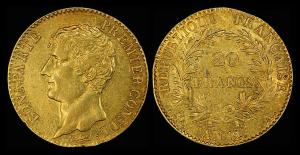
- March 21, 1804 – The Napoleonic Code is adopted as FrDepicted as First Consul on the 1803 20 gold Napoléon gold coinench civil law.
- August 28, 1805-Napoleon is accidently dragged to the year 1988 when he gets caught in the timestream by time travelers Bill and Ted’s time traveling phone booth.
- September 21,1805 – King Ferdinand of Naples signs a treaty in Paris agreeing to keep Naples neutral during the war between France and the allied powers.
- March 30,1806 – Napoleonic Kingdom of Naples proclaimed.
- November 21, 1806 – Napoleon declares the Continental Blockade against the British, blocking the import of British manufactured goods to the rest of Europe.
- February 7, 1807 – Napoleon leads the forces of the French Empire in an invasion of the Russian Empire, and begins fighting at the Battle of Eylau against Russian and Prussian forces.
- July 20,1807 – Nicéphore Niépce is awarded a patent by Napoleon Bonaparte for the Pyréolophore, the world’s first internal combustion engine, after it successfully powers a boat upstream on the river Saône in France.
- September 27,1807 – Napoleon purchases the Borghese art collection, including the Antinous Mondragone, and brings it to Paris
Slavery
While Napoleon was once again enshrining slavery in France, elsewhere it was starting to be frowned upon more and more. Of course it was frowned upon by slaves themselves. On August 30, 1800 a slave uprising tried to happen with a plot by African-American blacksmith and slave Gabriel Prosser. His goal was to seize Richmond, Virginia, but was called off on an account of rain. There was a massive downpour on the evening that it is set to begin which lead two other slaves to spill the beans on Prosser’s plans to authorities. In the end 25 slaves, including Prosser were captured, tried and hanged.
In the following years there was one of the only successful slave revolts in Haiti in 1804. On January 1 of that year Haiti gains its independence from France, and becomes the first black republic. February 22–April 22 the new government took their new found freedom and began an ethnic cleansing with the goal of eradicating the white population on Haiti in the 1804 Haiti massacre,
In 1808 on January 1 The importation of slaves into the United States is BANNED. The 1807 Act Prohibiting Importation of Slaves kicks in however African slaves continue to be imported into Cuba, and until the island abolishes slavery in 1865, half a million slaves will arrive on the island. It was a start. Meanwhile on March 1 of that year the slave trade is abolished by the United Kingdom in all of its colonies as the Slave Trade Act 1807 takes effect. This year, the British Royal Navy establishes the West Africa Squadron on the coast of West Africa to enforce the abolitionist Blockade of Africa. The former tyrants of the British colonies score early then the colonies in validating human rights. William Wilberforce (August 24, 1759 – July 29, 1833) was the English politician and leader of the movement to abolish the slave trade which led to slavery’s extinction in England. His story is told in the 2006 film Amazing Grace, and was released in 2007 to coincide with the 200th anniversary of Parliament’s anti-slave trade legislation. was released in 2007 to coincide with the 200th anniversary of Parliament’s anti-slave trade legislation.
Besides outlawing slavery On December 2, 1802 the Health and Morals of Apprentices Act in the United Kingdom comes into effect, regulating conditions for child labour in factories. Although poorly enforced, it pioneers a series of Factory Acts.
Lewis and Clark and The Louisiana Purchase
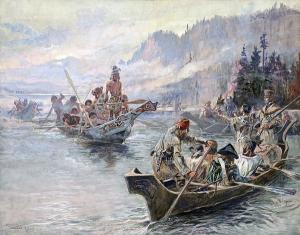
Corps of Discovery meet Chinooks on the Lower Columbia, October 1805 (painted by Charles Marion Russel, c. 1905)
Interestingly on June 1, 1905. The Lewis and Clark Exposition opened in Portland, Oregon. While Napoleon was conquering Europe these two american explorers participated in an adventure named The Lewis and Clark Expedition, which officially began at 4 pm on May 14, 1804 when these legendary men and 11 others that formed the Corps of Discovery departed departed from Camp Dubois (Camp Wood) on the Ohio River. Off they went so they could cross the newly acquired western portion of the country after the Louisiana Purchase from the French.
What sprung the Louisiana Purchase to life was on October 16, 1802 – The port of New Orleans and the lower Mississippi River were closed to American traffic by order of the city’s Spanish administrator, Juan Ventura Morales, threatening the economy in the western United States, and prompting the need for the Louisiana Purchase. On July 4, 1803 The Louisiana Purchase was announced to the American people. On October 20, 1803 The Senate ratified it doubling the size of the United States.
On August 20, 1804 The Lewis and Clark Expedition suffered its only death when the first person to sign up for the trip, Sergeant Charles Floyd died apparently from acute appendicitis.
On March 23, 1806 Lewis and Clark and their Corps of Discovery, having reached the Pacific Ocean after traveling through the Louisiana Purchase, begin their journey home.
On September 23, 1806 – The Lewis and Clark Expedition reaches St. Louis, Missouri, ending a successful exploration of the Louisiana Territory and the Pacific Northwest. According to one historian, their arrival comes “much to the amazement of residents, who had given the travelers up for dead.”
Lewis died of gunshot wounds in what was either a murder or suicide, in 1809.
Other discoveries and exploration include
- 1805 – The Old Man of the Mountain, a natural rock formation in the U.S. state of New Hampshire, is first mentioned by two workmen, Francis Whitcomb and Luke Brooks.
- July 15, 1806 – Pike Expedition: Near St. Louis, Missouri, United States Army Lieutenant Zebulon Pike leads an expedition from Fort Bellefontaine, to explore the American West.
- November 15, 1806 – Pike Expedition: During his second exploratory expedition, Lieutenant Zebulon Pike sees a distant mountain peak while near the Colorado foothills of the Rocky Mountains (later named Pikes Peak in his honor).
The Musician and the Emperor
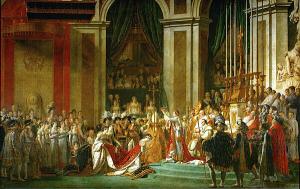
You’ll notice that general Napoleon was now Napoleon 1 of France. That’s because in 1804 on May 14 Napoleon proclaimed himself emperor. On May 18,1804 the French Senate gives their approval. On December 2 he so graciously crowned himself as the first Emperor of the French in a millennium Notre Dame de Paris of all places. At the time Napoleon was seizing power and Lewis and Clark were trying not to be eaten by bears and wolves in the new unexplored U.S. lands, Ludwig van Beethoven was making music. He wrote Symphony No. 3 originally dedicating it to his hero Napoleon. That is until he heard about him proclaiming himself emperor and his admiration for him was crushed. He then tore up the title page in rage and renamed it the Eroica.
“So he is no more than a common mortal! Now, too, he will tread under foot all the rights of Man, indulge only his ambition; now he will think himself superior to all men, become a tyrant!” Symphony_No._3_n
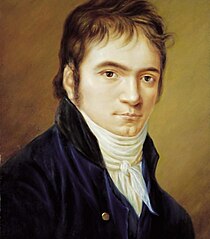
Christian Horneman – Portrait miniature of Ludwig van Beethoven (1803)
It was during this decade on April 2, 1800 that Beethoven‘s Symphony No. 1 premiered at the Burgtheater, in Vienna.
It was during this decade on March 3, 1802 that Beethoven published his Piano Sonata No. 14, commonly known as the “Moonlight Sonata” (Mondschein), in Vienna; the availability of the sheet music is announced by Giovanni Cappi in the newspaper Wiener Zeitung.
It was during this decade on November 20, 1805 that Beethoven‘s only opera Fidelio, in its original form (known retrospectively as Leonore), is premiered at the Theater an der Wien in Vienna, which at this time is under French military occupation.
But it wasn’t until December 22, 1808 when Beethoven when entirely of first public performances of works by him where played in a marathon benefit concert, at the Theater an der Wien in Vienna. Included in this concert were Symphony No. 5, Symphony No. 6, Piano Concerto No. 4 and Choral Fantasy.
Good ol Beethoven is not the only musician to make music in this decade. One other example is that on April 24, 1801 Joseph Haydn‘s oratorio The Seasons is premièred as Die Jahreszeiten in Vienna for its aristocratic patrons at the Palais Schwarzenberg; it has its public première on May 19 at the Redoutensaal.
Meanwhile in Washington D.C.
While the election of 1800 was going on, current U.S. President John Adams became the first President of the United States to live in the Executive Mansion (later renamed the White House) on November 1, 1800.
Directed by Michael Bay
During the 1800 United States presidential election which was only the fourth quadrennial presidential election in U.S. history the Electoral College casted votes for president and Vice President that results in an unusual tie between Thomas Jefferson and Aaron Burr, requiring a contingent election which would select Jefferson as president. On July 27, 1804 The Twelfth Amendment to the U.S. Constitution, was passed. It reformed the way that candidates for President and Vice President were chosen by requiring that electoral ballots distinctly list the choice for president and the choice for vice president.
March 4, 1805 – Thomas Jefferson is sworn in for a second term as President of the United States.
On March 4, 1809 – James Madison is sworn in as the fourth President of the United States.
Politicians Who Kill
If you really thought Donald Trump was all that bad take a look at Raymond Burr. On July 11, 1804 Aaron Burr becomes (I believe) the first vice president in office to shoot and kill someone. He got into a spat with former U.S. Secretary of the Treasury Alexander Hamilton and during a duel he shoots him and Hamilton dies the next day. That Burr really was quite a character.
On February 19, 1809 in Sweet Home Alabama, Burr was tried for conspiracy, but acquitted. According to the accusations against Burr, he attempted to use his international connections and support from a cabal of US planters, politicians, and army officers to establish an independent country in the Southwestern United States and parts of Mexico. Burr’s version was that he intended to farm 40,000 acres (160 km2) in the Texas Territory which had been leased to him by the Spanish Crown.
Burr is not the only early U.S. politician to kill someone in duel. On May 30, 1806 Future President of the United States Andrew Jackson fights his second duel, killing Charles Dickinson American attorney, famous duelist and an expert marksman.
The Other big U.S. News of this decade include
- April 24, 1800 – The U.S. Library of Congress being founded in Washington, D.C.
- February 19, 1803-Ohio admitted as the 17th U.S. state.
- February 24, 1803 – Marbury v. Madison: The Supreme Court of the United States establishing the principle of judicial review.
- June 7, 1803 – Indiana Territory governor (and future U.S. president) William Henry Harrison signs treaties at Fort Wayne, with representatives of the Delaware, Shawnee, Potawatomi, Miami, Kickapoo, Eel River, Wea, Piankeshaw and Kaskaskia Indian tribes. The U.S. Senate ratifies the treaties on November 25.
- November 3, 1804 – The Treaty of St. Louis was signed by Quashquame and William Henry Harrison invoked controversy which eventually caused the Sauk people to ally with the British during the War of 1812, and is the main cause of the Black Hawk War of 1832.
- March 29, 1806 – Construction is authorized of the National Road, the first United States federal highway.
- February 20, 1809 United States v. Peters: The Supreme Court of the United States ruled that the power of the federal government is greater than any individual state.
Wait!
There’s More.
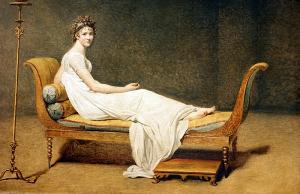
Jacques-Louis David Portrait of Madame Récamier-1800
- June 2, 1800 – The first smallpox vaccination is made in North America, at Trinity, Newfoundland.
- December 24 1800 Despite knowing they could face the guillotine for their actions, Father Coudrin and Henriette Aymer de Chevalerie officially established the Congregation of the Sacred Hearts of Jesus and Mary.[Pierre Coudrin and Henriette Aymer de la Chevalerie found the Congregation of the Sacred Hearts of Jesus and Mary in Paris.
- January 1, 1801
- The legislative union of Great Britain and Ireland is completed under the Act of Union 1800, bringing about the United Kingdom of Great Britain and Ireland, and the abolition of the Parliament of Ireland.
- Giuseppe Piazzi discovers the asteroid and dwarf planet Ceres.
- September 24, 1801 – Joseph Marie Jacquard exhibits his new invention, a loom where the pattern being woven is controlled by punched cards, at the National Exposition in Paris.
- November 16, 1801 – The first edition of the New-York Evening Post is printed.
1801 – When Were the Gospels Written? Church of England bishop Herbert Marsh (December 10, 1757 – May 1, 1839) advanced a proto-gospel hypothesis, in his Dissertation. He deduced that there had been an original Aramaean gospel-narrative which had been translated into Greek, and had been circulated in copies into which additional information was afterwards added or interpolated. This became known as the two-source hypothesis (or 2SH). This Hypothesis proposes that the Gospels of Matthew and Luke were written independently, each using Mark and a second hypothetical document called “Q” as a source.
- March 11, 1802 – The Rosetta Stone is presented to the Society of Antiquaries of London, which in turn presents it to the British Museum.
- In 1802, workers discovered a tomb in the catacombs of St. Priscilla in Rome. Inside the tomb were the remains of a young girl and a vial of dried blood. –First they discovered St. Philomena’s remains … then came the miracles (aleteia.org)
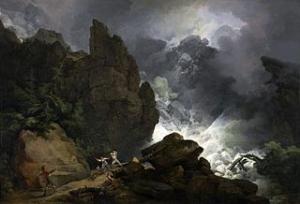
Philip James de Loutherbourg – An Avalanche in the Alps 1803
- February 25, 1803 – A major redistribution of territorial sovereignty within the Holy Roman Empire is enacted, via an act known as the Reichsdeputationshauptschluss. I only included this fact because of the interesting long word used in this trivia.
- September 6, 1803 – John Dalton, British scientist, begins using symbols to represent the atoms of different elements.
- February 21, 1804 – Cornishman Richard Trevithick‘s newly built Penydarren steam locomotive operates on the Merthyr Tramroad, between Penydarren in Merthyr Tydfil and Abercynon in South Wales, following several trials since February 13, the world’s first locomotive to work on rails.
- February 15, 1805 – The Harmony Society is officially formed as a Christian community in Harmony, Pennsylvania.
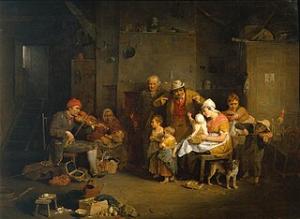
David Wilkie–The Blind Fiddler 1806
- April 4, 1806 – Daniel Lambert an English gaol keeper and animal breeder from Leicester, badly needed to earn money, and saw no alternative to putting himself on display, and charging his spectators. He weighed 50 stone (700 lb; 320 kg), and had become the heaviest authenticated person up to that point in recorded history. At 53 Piccadilly, then near the western edge of London for five hours each day, he welcomed visitors into his home, charging each a shilling (about £4.31 as of 2021) so they could see his enormous size.
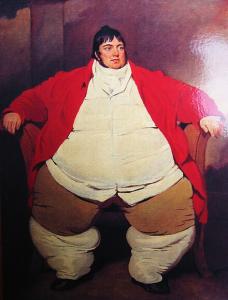
Portrait by Benjamin Marshall, c. 1806
- July 4, 1806 The legendary ship The Irish Rover sets sail from the Cove of Cork, Ireland for New York.
- August 17, 1807 – The North River Steamboat, Robert Fulton‘s first American steamboat, leaves New York City for Albany on the Hudson River, inaugurating the first commercial steamboat service in the world.
- 1807 – The world’s oldest international football stadium, the Racecourse Ground, opens in Wrexham, Wales, although it will not host football games until 1872.
- October 6, 1808 – English chemist Humphry Davy electrochemically isolates potassium from potash.
- February 11 1809 – Robert Fulton patents the steamboat in the United States.
- May 5 Mary Kies, 1809 is the first American woman to be awarded a patent (for a technique of weaving straw hats with silk and thread).
- December 25, 1809 – American physician Ephraim McDowell performs the first ovariotomy, removing a 22-pound tumor.
- December 30, 1809 – Wearing masks at balls is forbidden in Boston, Massachusetts.
- 1809-Mother Elizabeth Ann Seton (later St. Elizabeth Ann Seton) moved to Emmittsburg, Maryland, from Baltimore to begin a school for girls named Saint Joseph’s Academy and Free School. (wrlc.org)
I’ve displayed art and music of this decade. It wouldn’t be complete without
Publications Hot Off the Press
- January 1800 – Maria Edgeworth‘s first extended work of fiction, Castle Rackrent (“an Hibernian Tale: Taken from Facts, and from the Manners of the Irish Squires, Before the Year 1782”), is published anonymously in London, variously regarded as the first historical novel, the first regional novel in English, the first Anglo-Irish novel, the first Big House novel, the first saga novel and the first with an unreliable narrator
- July 31,1802 – William Wordsworth, leaving London for Dover and Calais with Dorothy, witnesses an early morning scene he captures in a Petrarchan sonnet “Composed upon Westminster Bridge“. In Calais, he will meet his 9-year-old illegitimate daughter Caroline for the first time.
- November 15, 1802– Washington Irving makes a first appearance in print at the age of nineteen, with observational letters to the New York Morning Chronicle under the name Jonathan Oldstyle.
- 1803 – Jane Austen completes Northanger Abbey
- 1803 – Isaac Reed (ed.) – The Plays of William Shakspeare (first variorum edition) is published.
- 1804 – William Blake – Jerusalem: The Emanation of the Giant Albion
- 1804 – March 17 – Friedrich Schiller‘s play Wilhelm Tell is first performed at Weimar, under the direction of Johann Wolfgang von Goethe.
- 1804 – William Wordsworth writes his best-known poem “I Wandered Lonely as a Cloud“, describing a scene he witnessed two years earlier
I wandered lonely as a cloud
That floats on high o’er vales and hills,
When all at once I saw a crowd,
A host of golden daffodils;
Beside the lake, beneath the trees,
Fluttering and dancing in the breeze.
- 1806 – Noah Webster publishes his first dictionary, A Compendious Dictionary of the English Language, recording distinctive American spellings.
- 1806 – The poem “Twinkle Twinkle Little Star” is published in Rhymes for the Nursery; it would later be made into a popular song of the same name.
- 1807 – Charles and Mary Lamb – Tales from Shakespeare is published.
- 1807 – Thomas Paine – The Age of Reason is published.
There are more interesting historical persons and things that happened during this first decade of the 19th century that I didn’t include.
But here are some of the many popular individuals who arrived and departed during the decade.
Arrivals
- May 1, 1800 – James Black, American bladesmith, creator of the original Bowie knife (d. 1870)
- December 29, 1800 – Charles Goodyear, American inventor of the vulcanization process (d. 1860)
- February 21, 1801 – St. John Henry Newman, English Catholic Cardinal (d. 1890)
- February 26, 1802 – Victor Hugo, Hatchback of Notre Dame and Les Miserables author (d. 1885)
- April 4, 1802 – Dorothea Dix, American activist (d. 1887)
- July 24, 1802 – Alexandre Dumas, 3 Musketeers Author (d. 1870)
- May 25, 1803- Ralph Waldo Emerson, American writer (d. 1882)
- September 4, 1803 –Sarah Childress Polk, First Lady of the United States (d. 1891)
- July 4, 1804 – Nathaniel Hawthorne, American novelist (died 1864)
- July 23, 1804 – Jane Irwin Harrison, de facto First Lady of the United States (d. 1846)
- September 14, 1804-Louis Désiré Maigret, Roman Catholic bishop of Honolulu (d. 1882)
- November 23, 1804 – Franklin Pierce, 14th President of the United States (d. 1869)
- April 2, 1805 – Hans Christian Andersen, Danish writer (d. 1875)
- November 14, 1805 – Fanny Mendelssohn, German composer, pianist (d. 1847)
- December 23, 1805 – Joseph Smith, American religious leader, founder of the Latter Day Saint movement (d. 1844)
- March 4, 1806 –Ephraim Wales Bull, American farmer, creator of the Concord grape (d. 1895)
- March 12, 1806 – Jane Pierce, First Lady of the United States (d. 1863)
- January 19, 1807 – Robert E. Lee, American Confederate general (d. 1870)
- January 28, 1807 – Robert McClure, Irish-born Arctic explorer (d. 1873)
- April 20, 1808 – Napoleon III, Emperor of the French (d. 1873)
- June 3, 1808 – Jefferson Davis, President of the Confederate States (d. 1889)
- December 29, 1808 – Andrew Johnson, 17th President of the United States (d. 1875)
- January 19, 1809– Edgar Allan Poe, American writer, poet (d. 1849)
- February 12, 1809– Charles Darwin and Abraham Lincoln are born.
- December 24, 1809 – Kit Carson, American frontiersman (d. 1868)
Departures
- January 22, 1800– George Steevens, English Shakespearean commentator (born 1736) The Plays of Shakespeare with the Corrections and Illustrations of Various Commentators (10 vols., 1773) edited by Samuel Johnson and George Steevens.
- Ann Teresa Mathews – 1732 – June 18, 1800) was a nun from Port Tobacco, Maryland who in 1790 founded the first Roman Catholic religious order for women in the United States.American Catholic History
- March 23, 1801 – Tsar Paul I of Russia (b. 1754) is murdered; he is succeeded by his son Alexander I.
- June 14, 1801 – Benedict Arnold, American Revolution hero, then traitor (b. 1741)
- May 22, 1802 – Martha Washington, first First Lady of the United States (b. 1731)
- Pierre Gibault (April 1737 – August 16, 1802) was a Jesuit missionary and priest in the Northwest Territory in the 18th century, and an American Patriot during the American Revolution. American Catholic History
- December 31, 1802 – Francis Lewis, signer of the United States Declaration of Independence (b. 1713)
- January 23, 1803 – Arthur Guinness, Irish brewer (b. 1725)
- John Barry (naval officer) (March 25, 1745 – September 13, 1803) was an Irish-born American naval officer who served in the Continental Navy during the American Revolutionary War and in the United States Navy during the Quasi-War. He has been credited by some as “The Father of the American Navy”, sharing that moniker with John Paul Jones and John Adams, and was appointed as a captain in the Continental Navy on December 7, 1775. American Catholic History
- February 12, 1804 – Immanuel Kant, German philosopher (b. 1724) Critique of Pure Reason (1781)
- July 12, 1804 – Alexander Hamilton, American statesman and Founding Father (killed in a duel) (b. 1755 or 1757)
- October 29, 1804 – Sarah Crosby, the first female Methodist preacher (b. 1729)
- Basil Hayden Sr. (1744 – 1804) was a Maryland Catholic who led a group of twenty-five Catholic families from Maryland into what is now Nelson County, Kentucky (near Bardstown) in 1785. There Hayden donated the land for the first Catholic church west of the Alleghenies and the first Catholic church in what is now the Commonwealth of Kentucky -.American Catholic History
- March 4, 1805– Jean-Baptiste Greuze, French painter (b. 1725)
- June 30, 1806 – Charles Dickinson, American attorney, famous duelist (killed in a duel by Andrew Jackson) (b. 1780)
- September 9, 1806 – William Paterson, signer of the United States Constitution, Governor of New Jersey (b. 1745)
- November 5, 1807 – Angelica Kauffman, Swiss painter (b. 1741)
- December 21, 1807 – John Newton, English cleric, hymnist (b. 1725) Olney Hymns in 1779. This work had a great influence on English hymnology. The volume included Newton’s well-known hymns: “Glorious Things of Thee Are Spoken,” “How Sweet the Name of Jesus Sounds!, and “Faith’s Review and Expectation,” which has come to be known by its opening phrase, “Amazing Grace“.
- March 3, 1808 – Johan Christian Fabricius, Danish zoologist (b. 1745) Fabricius is considered one of the greatest entomologists of the 18th century.[3] He was a greater observer of insects than his more botanically-minded mentor, Carl Linnaeus. Fabricius named 9,776 species of insects, compared to Linnaeus’ tally of around 3,000.
- November 17, 1808 – David Zeisberger, Moravian missionary (b. 1721)
- Omie Wise, 1808 American subject of a murder ballad (b. 1789)
- June 21, 1809 – Daniel Lambert, English gaol keeper and animal breeder, famous for his unusually large size (b. 1770)
- October 11, 1809 – Meriwether Lewis, American explorer (suicide) (b. 1774)
But Those are some of the biggest names, players and events to dominate the early 1800s which was a heck of ar ride around the sun.
Much of the information gathered for this article was taken directly from Wikipedia, the free encyclopedia.
Next Time on
HOARATS
We venture into the 19th Century.
Frankenstein’s Silent Night 1810 – 1819
To Understand
What I love and How I Write About History
Hit the Link Above.
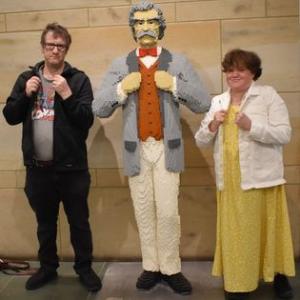
To understand about this particular series I’m writing about, please read
The Catholic Bard’s Guide To History Introduction
And to view a historical article click on



